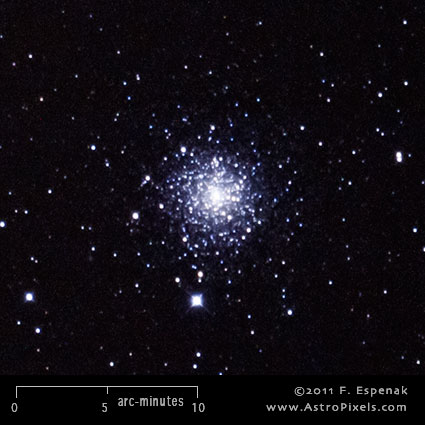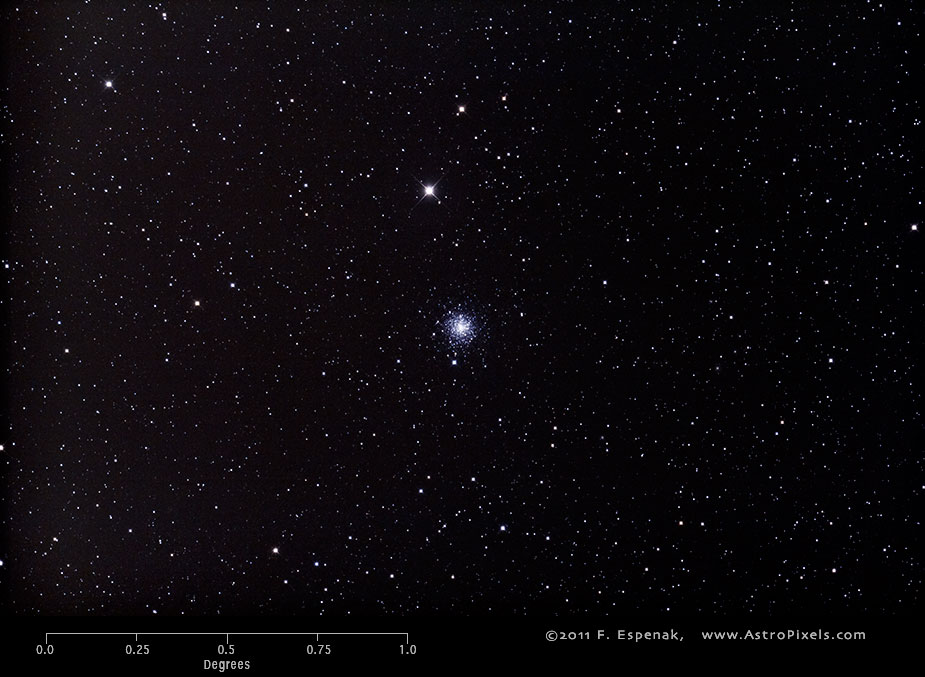
M30
Messier 30 or M30 (also designated NGC 7099) is a globular cluster in the constellation Capricornus. It has an apparent visual magnitude of 7.2 and its angular diameter is 11 arc-minutes. M30 lies at an estimated distance of 26,100 light years. The Equinox 2000 coordinates are RA= 21h 40.4m, Dec= -23° 11´ which makes M30 best seen during the autumn. The Messier Autumn Star Chart shows the position of all Messier objects visible during that season.
The image above shows the uncropped view of M30 through the Takahashi E-180 Astrograph (North is to right). A 3x enlargement of this image appears to the right.
This globular cluster was discovered by Messier in 1764 but he was unable to resolve it into individual stars. According to Recio-Blanco et al.(2005), the distance of M30 is 29,460 light years and its diameter is 100 light years. Its estimated mass is 300,000 solar masses and it contains 13 variable stars.
For more information, see the Messier Catalog as well as specific entries for M30 in Wikipedia and SEDS.
Messier's Description of M30
August 3, 1764
`Nebula discovered below the tail of Capricorn, very near to the star 41 of that constellation, of 6th magnitude, according to Flamsteed. One sees it with difficulty with an simple refractor of 3.5 feet. It is round and contains no star; its position determined from Zeta Capricorni, M. Messier reported it on chart of the Comet of 1759. Mem. Acad. 1760, pl. II.' (diam. 2')
Technical Details
- Object: M30
- Other Names: NGC 7099
- Object Type: globular cluster
- Object Data: Apparent Magnitude = 7.2, Angular Size = 11 arc-minutes
- Object Position (Equinox 2000): RA= 21h 40.4m, Dec= -23° 11´, Constellation = Capricornus
- Date/Time: 2011 Oct 19 at 04:00 UTC
- Location: Bifrost Astronomical Observatory, Portal, AZ
- Mount: Astro-Physics 1200GTO
- Telescope: Takahashi Epsilon 180 Hyperbolic Astrograph
- Camera: Canon EOS 550D (Rebel T2i) (modified with a Baader UV/IR filter)
- Field of View: 1.70° x 2.56° at 1.7 arc-sec/pixel (web version: 10.0 arc-sec/pixel)
- Exposure: 8 x 300s, f/2.8, ISO 800
- File Name: M30-01w.jpg
- Processing (Adobe Camera Raw): Graduated Filter, Vignetting Correction, Noise Reduction, White Balance, Curves
- Processing (Photoshop CS5): Average Images, Curves, Noise Reduction
- Original Image Size: 3454 × 5179 pixels (17.9 MP); 11.5" x 17.3" @ 300 dpi
- Rights: Copyright 2011 by Fred Espenak. All Rights Reserved. See: Image Licensing.
